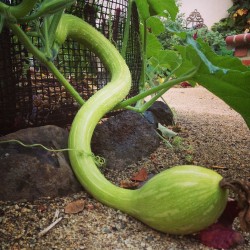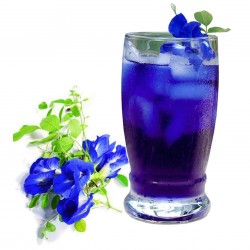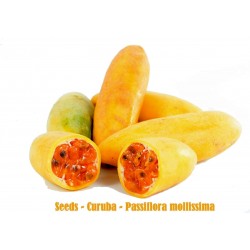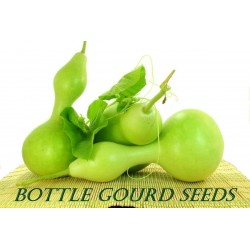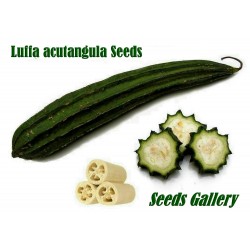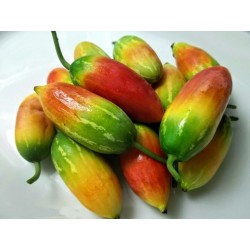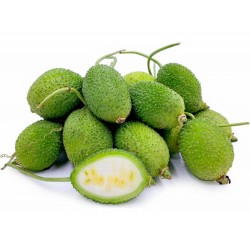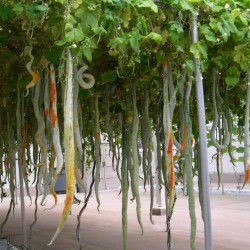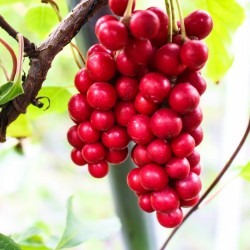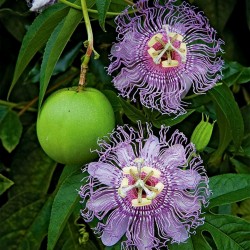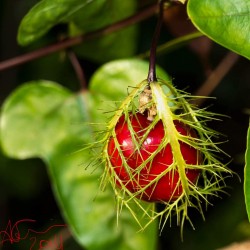Seeds Gallery Com,
5/
5
<meta http-equiv="Content-Type" content="text/html; charset=UTF-8" />
<h2><strong>Maypop, Mor Çarkıfelek Tohumları (Passiflora incarnata)</strong></h2>
<h2><span style="color: #ff0000;"><strong>5 tohum paketi için fiyat.</strong></span></h2>
<p>Passiflora incarnata, çarkıfelekgiller (Passifloraceae) familyasından çarkıfelek cinsinin en kuzeyde yetişen türüdür.</p>
<p>Çarkıfelek adıyla bilinen tavuk yumurtası büyüklüğünde ve şeklindeki sarımsı meyveleri (İngilizce: maypop) insanlarca tüketildiği için Güneydoğu ABD'de ziraati yapılır. Bitki, asma sülüğü gibi helezonik tutmaçlarla tutunarak hızlı büyür. Yaprakları üç lopludur. Passiflora cinsi içinde Sarı çarkıfelekten sonra soğuğa en dayanıklı tür olup <strong>-20</strong> dereceye kadar kökleri dayanabilmekte ve kışın ölen bitki bu sayede yazın tekrar hayata dönebilmektedir. ABD'nin güneydoğusunda subtropikal ve soğuk iklim bölgelerine bu sayede yayılabilmiştir.</p>
<p>Bitkiden ayrıca ilaç sanayinde de yararlanılmaktadır. "Passiflora" adlı bir ilacın üretiminde bu bitki ve meyveleri kullanılmaktadır.</p>
<p>Genellikle maypop, mor çarkıfelek, gerçek çarkıfelek, yabani kayısı ve vahşi tutku asma olarak bilinen Passiflora incarnata, tırmanma veya sondaki saplarla hızlı büyüyen çok yıllık bir asmadır. Çarkıfelek cinsi Passiflora'nın bir üyesi olan maypop, belirgin stilleri ve organlarındaki büyük, karmaşık çiçeklere sahiptir. Çarkıfelek türünün en sert türlerinden biri olan güney Amerika'da yaygın bir kır çiçeği. Tennessee bölgesindeki Cherokee buna ocoee adını verdi; Ocoee Nehri ve vadisi, Tennessee eyalet kır çiçeği olan bu bitkinin adını almıştır. Bu ve diğer çarkıfelekleri, Körfez fritillary için özel larva konakçı bitkilerdir ve alacalı fritiller kelebekler için münhasır değildir.</p>
<p>Sapları pürüzsüz veya tüylü olabilir; uzun ve takipçidirler, birçok dalları vardır. Yapraklar alternatif ve palmately 3 loblu ve bazen 5 loblu, 6-15 santimetre (2.4-5.9 inç) ölçülerindedir. Yaprak sapındaki bıçağın tabanında iki karakteristik bezleri vardır. Çiçeklerin beş mavimsi-beyaz yaprakları vardır. Yaprakları ve organlarındaki ince uzantıların bir yapısı olan beyaz ve mor bir korona sergilerler. Büyük çiçek tipik olarak yaprakları ve sepalsın üstünde bir halkada düzenlenir. Bombus arıları ve marangoz arılar gibi böcekler tarafından tozlaşırlar ve kendiliğinden sterildirler. Çiçek normalde Temmuz ayında çiçek açar.</p>
<p>Maypop olarak da adlandırılan etli meyve, bir tavuk yumurtası büyüklüğünde oval sarımsı bir meyvedir; ilk başta yeşil, ama olgunlaştıkça turuncu olur. Diğer passifloralarda olduğu gibi, zebra longwing ve Gulf fritillary dahil olmak üzere bir dizi kelebek türünün larva gıdasıdır. Birçok durumda, meyvesi yaban hayatı ile çok popülerdir. Yumurta şeklindeki yeşil meyveler üzerine basıldığında 'patlayabilir'. Bu fenomen P. incarnata'ya ortak adını verir.</p>
<p>Maypop çalılıklar, rahatsız alanlarda, nehir kıyılarının yakınında ve biçilmemiş meraların, yol kenarlarının ve demiryollarının yakınında meydana gelir. Güneş ışığının bol olduğu alanlarda büyür. Bir orman gölgelik altındaki gölgeli alanlarda bulunmaz.</p>
<p>Mutfak kullanımı</p>
<p>Yemek pişirmede, bu çeşitliliğin meyvesi bazen reçel ve jöleler için veya ticari olarak yetiştirilen Güney Amerika nispi Passiflora edulis'in yerine kullanılır - meyve karşılaştırılabilir boyut ve meyve suyu verimine sahiptir, bu nedenle soğutulmuş maypop suyu sıcak yaz aylarında lezzetli bir muameledir. hava. Meyveler elden yenebilir ve tarihsel olarak Güney ve Yerli Amerikalıların sömürge yerleşimcilerinin gözdesi oldu. Bugün, bu amaç için Amerikan Güneydoğu'daki bahçelerde ve Orta Atlantik'in bazı bölümlerinde ve gösterişli menekşe çiçeklerinde yetişen çok yaygın bir bitkidir [17] ve hala adı ile kanıtlandığı gibi Cajuns'un gözdesi bitki: liane de el bombası veya "nar asma".</p>
<p>Tıbbi kullanım</p>
<p>Etki</p>
<p>Bir derlemede anksiyete bozukluklarında P. incarnata'ya destek bulundu. Diğer gözden geçirmeler, kanıtların sağlık etkileri hakkında herhangi bir iddiada bulunmak için yetersiz olduğunu bulmuştur.</p>
<p>Etkileşimler</p>
<p>Aşağıdaki ilaçlarla olası etkileşimler:</p>
<p>Sakinleştirici</p>
<p>Antiplateletler ve antikoagülanlar</p>
<p>Monoamin oksidaz inhibitörleri (MAOI'ler)</p>
<p>P. incarnata, yukarıda listelenen ilaçların ana etkilerini veya yan etkilerini artırabilir.</p>
<p>Hamile veya emziren kadınlar P. incarnata kullanmamalıdır. Bitki bileşiklerinin üreme veya doğmamış çocuk üzerindeki etkileri henüz test edilmemiştir. Bu tesisin tüketimi, araç ve makine kullanma yeteneğine zarar verebilir.</p>
<p>Tarihsel kullanımlar ve halk hekimliği</p>
<p>Tarihsel olarak, bitki sinir kaygısı ve uykusuzluk tedavisinde bitkisel ilaç olarak kullanılmıştır. Kuru, öğütülmüş bitki, Avrupa'da bir çay kaşığı çay içerek sıklıkla kullanılır. Sakinleştirici niteliklere ve plasebodan başka tıbbi faydalara rağmen, sakinleştirici bir sakız bile üretilmiştir.</p>
<p>Hipertansiyonu azaltmak için P. incarnata kullanılmıştır. Yapraklardan metanol ekstraksiyonlarının farelerde etkili bir antitussif olduğu bildirilmiştir.</p>
<p>Avrupa'ya getirildikten sonra, zihinsel stres, anksiyete sinirlilik, kabızlık, hazımsızlık, hafif enfeksiyonlar ve uykusuzluk gibi hafif semptomların hafifletilmesi için doğal bir ilaç olarak herbolojide popüler bir ilaç haline geldi. "Bugün, çarkıfelek resmi olarak Fransa, Almanya ve İsviçre'nin ulusal farmakopelerinde yer alıyor ve aynı zamanda İngiliz Bitkisel Farmakopesi ve İngiliz Bitkisel Özeti, ESCOP monografları, EMA'nın Topluluk Bitkisel Monografları, Alman Standart Lisansları, Alman Homoeopatik Farmakopesi, Amerika Birleşik Devletleri Homoeopatik Farmakopesi ve Mısır Farmakopesi.Polonya'da histeri ve nevrasteni gibi bozuklukları tedavi etmek için reçete edilmiştir.Şu anda P. incarnata yaygın olarak fitoterapide hafif bir yatıştırıcı olarak kullanılmaktadır ve Mevcut Avrupa ve İngiliz Farmakopesine dahil edilen botanik ilaçlar bitkinin kurutulmuş hava kısımlarıdır ".</p>
<p>Kuzey Amerika'da ishal, adet öncesi sendromu, dismenore, nevralji, yanıklar, hemoroidler, uykusuzluk, kas krampları, histeri, nevralji ve çeşitli durumlar için ağrı kesici olarak kullanılır. P. incarnata hala Yerli Amerikalılar tarafından kullanılmaktadır, örneğin, Cherokees bitkinin kökünü topikal antienflamatuar ilaç olarak kullanır. Köklerden yapılan çay, karaciğer ve cilt kaynatmaları için tonik olarak kullanılır. P. incarnata özleri ayrıca sinirlilik, karın krampları ve anksiyetenin giderilmesi için de kullanıldı.</p>
<p>Dünyanın diğer bölgelerinde, P. incarnata kısmen farklı hastalıkların tedavisinde kullanılır. Örneğin, Arjantin ve Meksika'da sakinleştirici etkileri için tüketilirken, Brezilya'da analjezik, antispazmodik, anti-astımlı, cinayet ve yatıştırıcı olarak kullanılır. Bununla birlikte Hindistan'da morfin bağımlılığını tedavi etmek için kullanılmıştır, ancak Vietnam'da uykusuzluk, kaygı ve yüksek tansiyon bu bitkiden elde edilen ekstraktlarla tedavi edilmiştir. Orta Doğu'da P. incarnata'nın biraz farklı uygulamaları vardır, örneğin Türkiye'de dismenore, epilepsi, uykusuzluk, nevroz ve nevralji P. incarnata ile tedavi edilir. Ancak Irak'ta sakinleştirici ve narkotik bir ilaç olarak da kullanılmıştır. "Ruanda, Kenya ve Kongo'nun Afrika ülkelerinde P. incarnata, sakinleştirici, sinir, anti-spazmodik ve analjezik etkileri için bitki uzmanları ve doğal sağlık uygulayıcıları tarafından halk ilacı olarak kullanılmaktadır. Avustralya'da, genellikle sakinleştirici ve anksiyolitik ilaç.</p>
<p>maddeler</p>
<p>P. incarnata'daki bazı önemli maddeler flavonoidlerdir, ancak aynı zamanda alkaloidler ve diğer fito-bileşenler de bulunabilir.</p>
<p>Flavonoidler P. incarnata'nın ana bileşenidir. Toplam içeriğin% 2,5'ine kadar ulaşabilirler. Flavonoidlerin en büyük konsantrasyonunun yapraklarda olduğu bildirilmiştir. P. incarnata'da aşağıdaki flavonoidler bulunabilir: chrysin, apigenin, luteolin, quercetin, kaempferol ve isovitexin. [14] Flavonoid chrysinin, P. incarnata'nın yatıştırıcı etkisinden sorumlu ana madde olduğu düşünülmektedir. Anksiyete azaltıcı özelliğe chrysinin GABA-Benzodiazepinreseptörlere bağlanması neden olmaktadır. [15] P. incarnata'da az miktarda alkaloid bildirilmiştir (<% 0.005). Alkaloitlere örnekler: harmol, harmin, harmalol. [14] P. incarnata'da bulunan diğer maddeler arasında mono- ve polisakkaritler, amino asitler ve uçucu yağlar bulunur.</p>
<p>yetiştirme</p>
<p>Weediness</p>
<p>P. incarnata potansiyel olarak tarımsal bir ot haline gelebilir. Passiflora'nın tarımsal amaçlarla tanıttığı cinsiyet, dünyanın bazı bölgelerinde önemli bir ot olarak rapor edilmiştir. Bu bitki, şu iki yetkili kaynağa göre Amerika Birleşik Devletleri Tarım Bakanlığı tarafından invaziv olarak listelenmiştir: Kentucky Weeds ve bitişik eyaletler: bir alan kılavuzu [20] ve Amerika Birleşik Devletleri ve Kanada Weeds.</p>
<p>Maypop'un yayılmasını önlemek için emicilerin düzenli olarak çıkarılması olarak mekanik kontrol tavsiye edilir. Ayrıca yaylanmayı sınırlandırmak için sarmaşıkların kafes ve çitler üzerine eğitilmesi tavsiye edilir.</p>
<p>Diğer potansiyel kullanım</p>
<p>P. incarnata ekstreleri UV ışınlarına karşı koruyucu bir savunma ile organik güneş kremleri üretmek için potansiyel olarak kullanılabilir. Bu bitki bileşiklerinin kullanımı, güneşten koruyuculardaki sentetik UV filtrelerinin konsantrasyonunu azaltacaktır.</p>
V 18 PI




